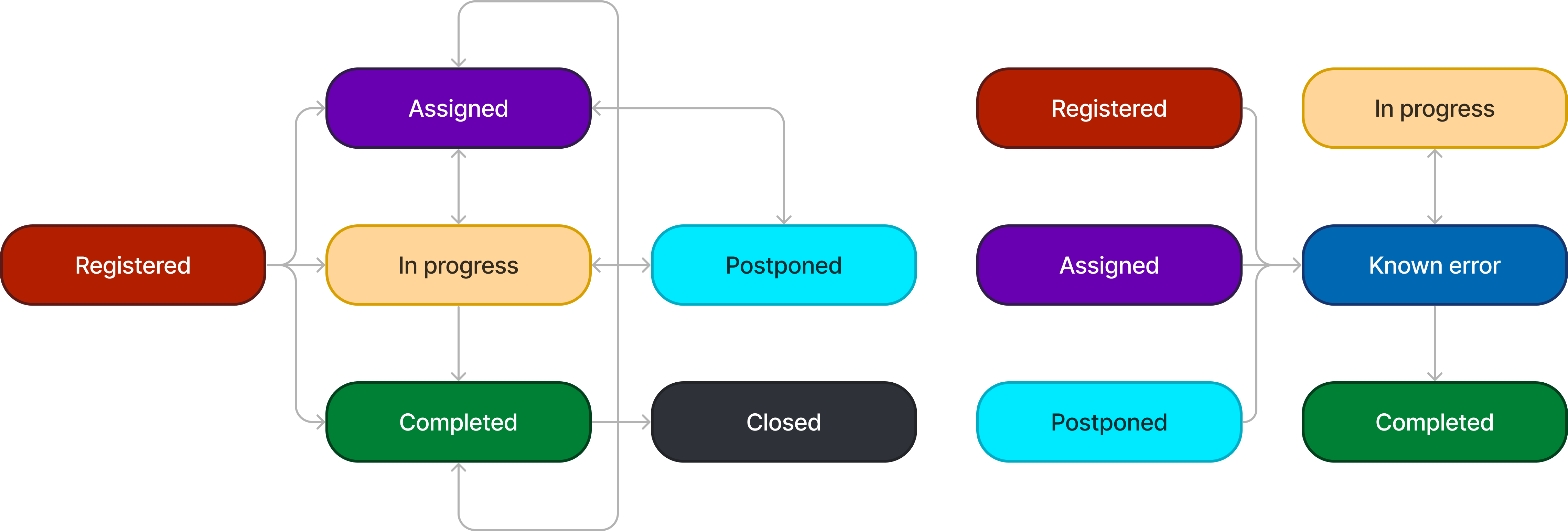Process Problems
The following diagram illustrates the state model of problems.

State description
The following table lists and describes the states available for problems.
| State | Description | Available transitions |
|---|---|---|
| Registered | The problem is detected and recorded, but not yet categorized. |
|
| Assigned | The problem is categorized and assigned to a relevant person or group. |
|
| In progress | The agent started working on the problem. |
|
| Postponed | Resolution of the problem is postponed for a known period. If the problem affects business functions, it must at least have a temporary workaround. |
|
| Known Error | The problem automatically transitions into this state if:
|
|
| Completed | The work on the problem is Completed when the agent has come up with a permanent solution for the issue. In this case, the state has to be changed to Completed, so that the caller could perform the testing. If the tests are successful, the problem has to be Closed. |
|
| Closed | After the problem is resolved, it has to be Closed. Only a problem manager can do it. |
* Only automatic transition to this state is possible, when an Actual or Fixed known error is attached to the problem.
Assign and update problems
To assign a problem, follow these steps:
- Navigate to Problem Management → All Problems.
- Open the problem you need to assign.
- Click the magnifier icon next to the Assigned group or Assigned user field.
- Select the responsible person or group to assign the problem.
- Click Save or Save and exit to apply the changes.
Alternatively, simply click the Assign to me button to assign a problem to the current user. The button is available for all agents who are not currently assigned to the problem, but have the ITSM_agent role or are members of the group specified in the Assignment group field.
The Assign to me button moves the problem into the Assigned state.
Whereas the Assigned to field is completed with the name of the current user, the Assignment group field is completed depending on the following conditions:
- If the Primary group (primary_group) field on the current user's page is completed, then an empty Assignment group field is completed with the primary group value on the problem form.
- If the Primary group field on the current user's page is completed, but the Assignment group on the problem form is filled with a different value, then the Assignment group is completed with the primary group value.
- If the Primary group field is empty, but the Assignment group is completed with a group to which the user belongs, then the Assignment group field keeps its value.
- If the Primary group field is empty, but the Assignment group is completed with a group to which the current user is does not belong, then the Assignment group is cleared.
If the Assignment group field is updated when the Assigned user field is empty, then the system sends a notification to the members of the assigned group.
To update a problem, follow these steps:
- Navigate to Problem Management → All Problems.
- Open the problem you need to update.
- Change the fields as required.
- Click Save or Save and exit to apply the changes.
Closure information
Based on the state model, the problem has to be closed when it has been fully processed. The Closure Information tab appears when the problem state is Completed.
| Field | Mandatory | Description |
|---|---|---|
| Complete originators | N | Select this checkbox to make the originators related to this problem be completed along with it. |
| Closure code | Y | Specify a closure code:
|
| Closure notes | Y | Specify some notes summarizing the implementation process. You can add a quick response by clicking the Quick Responses widget icon , if the widget is added to the form. Read more in the Quick Responses article. |